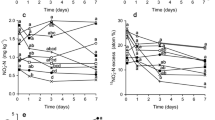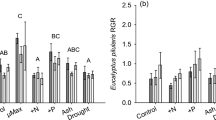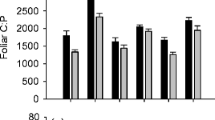Abstract
The effects of a range of fertilizer applications and of repeated low-intensity prescribed fires on microbial biomass C and N, and in situ N mineralization were studied in an acid soil under subalpine Eucalyptus pauciflora forest near Canberra, Australia. Fertilizer treatments (N, P, N+P, line + P, sucrose + P), and P in particular, tended to lower biomass N. The fertilizer effects were greatest in spring and smaller in summer and late actumn. Low-intensity prescribed fire lowered biomass N at a soil depth of 0–5 cm with the effect being greater in the most frequently burnt soils. No interactions between fire treatments, season, and depth were significant. Only the lime + P and N+P treatments significantly affected soil microbial biomass C contents. The N+P treatment increased biomass C only at 0–2.5 cm in depth, but the soil depth of entire 0–10 cm had much higher (>doubled) biomass C values in the line + P treatment. Frequent (two or three times a year) burning reduced microbial boomass C, but the reverse was true in soils under forest burn at intervals of 7 years. Soil N mineralization was increased by the addition of N and P (alone or in combination), line + P, and sucrose + P to the soil. The same was true for the ratio of N mineralization to biomass N. Soil N mineralization was retarded by repeated fire treatments, especially the more frequent fire treatment where rates were only about half those measured in unburnt soils. There was no relationship between microbial biomass N (kg N ha-1) and the field rates of soil N mineralization (kg N ha-1 month-1). The results suggest that although soil microbial biomass N represents a distinct pool of N, it is not a useful measure of N turnover.
Similar content being viewed by others
References
Anderson JPE, Domsch KH (1978) A physiological method for the quantitative measurement of microbial biomass in soil. Soil Biol Biochem 10: 215–221
Bauhus J, Khanna PK (1994) Carbon and nitrogen turnover in two acid forest soils of southeast Australia as affected by phosphorus addition and drying and rewetting cycles. Biol Fertil Soils 17: 212–218
Bekunda MA (1987) Characterisation and transformation of phosphorus in forest soils. PhD thesis, The Australian National University, Canberra
Bell RL, Binkley D (1989) Soil nitrogen mineralization and immobilization in response to periodic prescribed fire in a loblolly pine plantation. Can J For Res 19: 816–820
Bristow AW, Jarvis SC (1991) Effects of grazing, and nitrogen fertiliser on the soil microbial biomass under permanent pasture. J Sci Food Agric 59: 9–21
Christie P, Beattie JAM (1989) Grassland soil microbial biomass and accumulation of potentially toxic metals from long-term slurry application. J Apple Ecol 26: 597–612
Falkiner RA, Khanna PK, Raison RJ (1993) Effect of superphosphate addition on N mineralization in some Australian forest soils. Aust J Soil Res 31: 285–296
Heffernan B (1985) A handbook of methods of inorganic chemical analysis for forest soils, foliage and water. Division of Forestry, CSIRO, Canberra
Hesebe A, Kanazawa S, Takai Y (1985) Microbial biomass in paddy soil. II. Microbial biomass carbon measured by Jenkinson's fumigation method. Soil Sci Plant Nutr 31: 349–359
Hossain AKMA (1990) Estimation of microbial biomass nitrogen in some Australian forest soils. PhD thesis, The Australian National University, Canberra
Hossain AKMA, Khanna PK, Field JB (1993) Acid-peroxide digestion procedure for determining total nitrogen in chloroform-fumigated and non-fumigated soil extracts. Soil Biol Biochem 25: 967–969
Jenkinson DS (1988) Determination of microbial biomass carbon and nitrogen in soil. In: Wilson JR (ed) Advances in nitrogen cycling in agricultural ecosystems. CAB International, Wallingford, pp 368–386
Jenkinson DS, Ladd JN (1981) Microbial biomass in soik: Measurement and turnover. Soil Biochem 5: 415–471
Khanna PK, Raison RJ, Falkiner RA (1986) Exchange characteristies of some acid organic-rich forest soils. Aust J Soil Res 24: 67–80
Keith H (1991) Effects of fire and fertilization on nitrogen cycling and tree growth in a subalpine eucalypt forest. PhD thesis, The Australian National University, Canberra
Leuning R, Sands P (1989) Theory and practice of a portable photosynthesis instrument. Plant Cell Environ 12: 669–678
Nöhrstedt H-Ö, Arnebrant K, Bååth E, Söderström B (1989) Changes in carbon content, respiration rate, ATP content, and microbial biomass in nitrogen-fertilized pine forest soils in Sweden. Can J For Res 19: 323–328
Pietikäinen J, Fritze H (1993) Microbial biomass and activity in the humus laver following burning: short-term effects of two different fires. Can J For Res 23: 1275–1285
Raison RJ, Khanna PK, Woods PV (1985) Transfer of elements to the atmosphere during low-intensity prescribed fires in three Australian sub-alpine eucalypt forests. Can J For Res 15: 657–664
Raison RJ, Woods PV, Khanna PK (1986) Decomposition and accumulation of litter after fire in sub-alpine eucalypt forests Aust J Ecol 11:9–19
Raison RJ, Connell MJ, Khanna PK (1987) Methodology for studying fluxes of soil mineral-N in situ. Soil Biol Biochem 19:521–530
Raison RJ, Keith H, Khanna PK (1990a) Effects of fire on the nutrient-supplying capacity of forest soils. In: Dyck WJ, Mecs CA (eds) Impact of intensive harvesting on forest site productivity. Forest Research Institute, Rotorua, FRI Bull 159: 39–54
Raison RJ, Khanna PK, Connell MJ, Falkiner RA (1990b) Effects of water availability and fertilization on nitrogen cycling in a stand of Pinus radiata. For Ecol Manage 30:31–43
Raison RJ, Connell MJ, Khanna PK, Falkiner RA (1992) Effects of irrigation and nitrogen-fertilisation on fluxes of soil mineral introgen in a stand of Pinus radiata. For Ecol Manage 52:43–64
Raison RJ, O'Connell AM, Khanna PK, Keith H (1993) Effects of repeated fires on nitrogen and phosphorous budgets and cycling processes in forest ecosystems. In: Trabaud L, Prodon R (eds) Fire in Mediterranean ecosystems. EEC Publication, Belgium, pp 347–363
Schnürer J, Clarholm M, Rosswall T (1985) Microbial biomass and activity in an agricultural soil with different organic matter contents. Soil Biol Biochem 17:611–618
Shen SM, Hart PBS, Powlson DS, Jenkinson DS (1989) The nitrogen cycle in the Broadbalk wheat experiment: 15N-labelled fertilizer residues in the soil and in the soil microbial biomass. Soil Boil Biochem 21:529–533
Singh JS, Raghubanshi AS, Singh RS, Srivastava SC (1989) Microbial biomass acts as a source of plant nutrients in dry tropical forest and savanna. Nature (London) 338:499–500
Singh RS, Srivastava SC, Raghubanshi AS, Singh JS, Singh SP (1991) Microbial C, N and P in dry tropical savanna: Effects of burning and grazing. J Appl Ecol 28:869–878
Smith JL, Paul EA (1990) The significance of soil microbial biomass estimations. Soil Biochem 6:357–396
Sparling GP, Feltham CW, Reynolds J, West AW, Singleton P (1990) Estimation of soil microbial C by a fumigation-extraction method: Use on soils of high organic matter content, and a reassessment of the kEC-factor. Soil Biol Biochem 22:301–307
Srivastava SC, Jha AK, Singh JS (1989) Changes with time in soil microbial biomass C, N, and P of mine spoils in a dry tropical environment. Can J Soil Sci 69:849–855
Stace HCT, Hubble GD, Brewer R, Northcote KH, Sleeman JR, Mulchay MJ, Hallsworth EG (1968) A handbook of Australian soils. Rellim Tech Pub, Adelaide, South Australia
Tateishi T, Horikoshi T, Tsubota H, Takahashi F (1989) Application of the chloroform fumigation-incubation method to the estimation of microbial biomass in burned and unburned Japanese red pine forests. Microb Ecol 62:163–172
West AW, Sparling GP (1986) Modifications to the substrate-induced respiration method to permit measurements of microbial biomass in soils of differing water contents. J Microb Methods 5:177–189
Author information
Authors and Affiliations
Rights and permissions
About this article
Cite this article
Hossain, A.K.M.A., Raison, R.J. & Khanna, P.K. Effects of fertilizer application and fire regime on soil microbial biomass carbon and nitrogen, and nitrogen mineralization in an Australian subalpine eucalypt forest. Biol Fertil Soils 19, 246–252 (1995). https://doi.org/10.1007/BF00336167
Received:
Issue Date:
DOI: https://doi.org/10.1007/BF00336167




